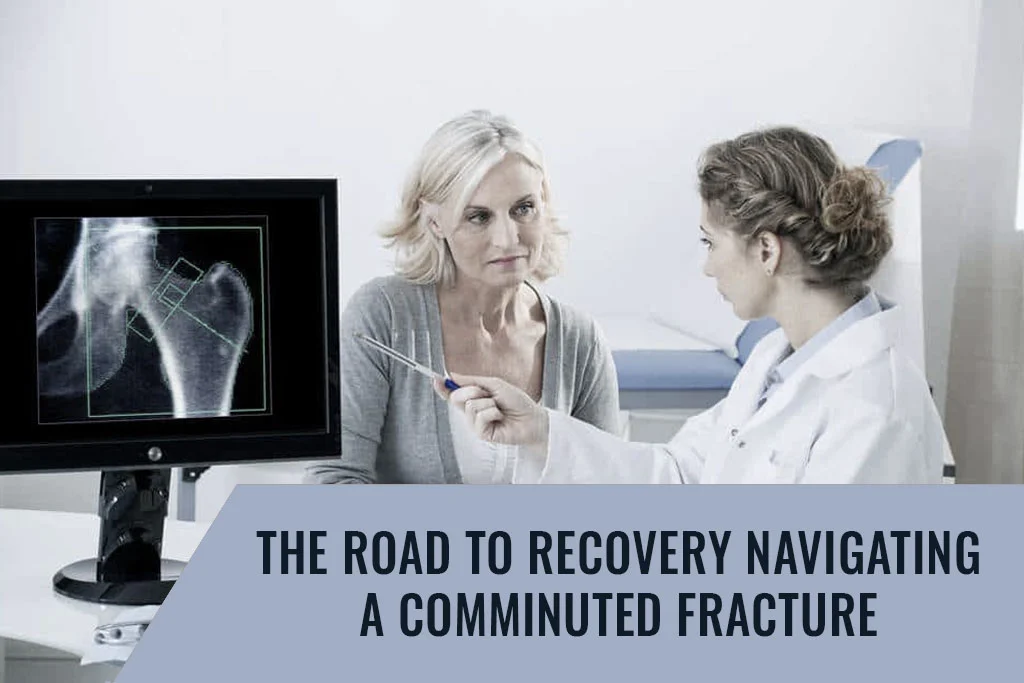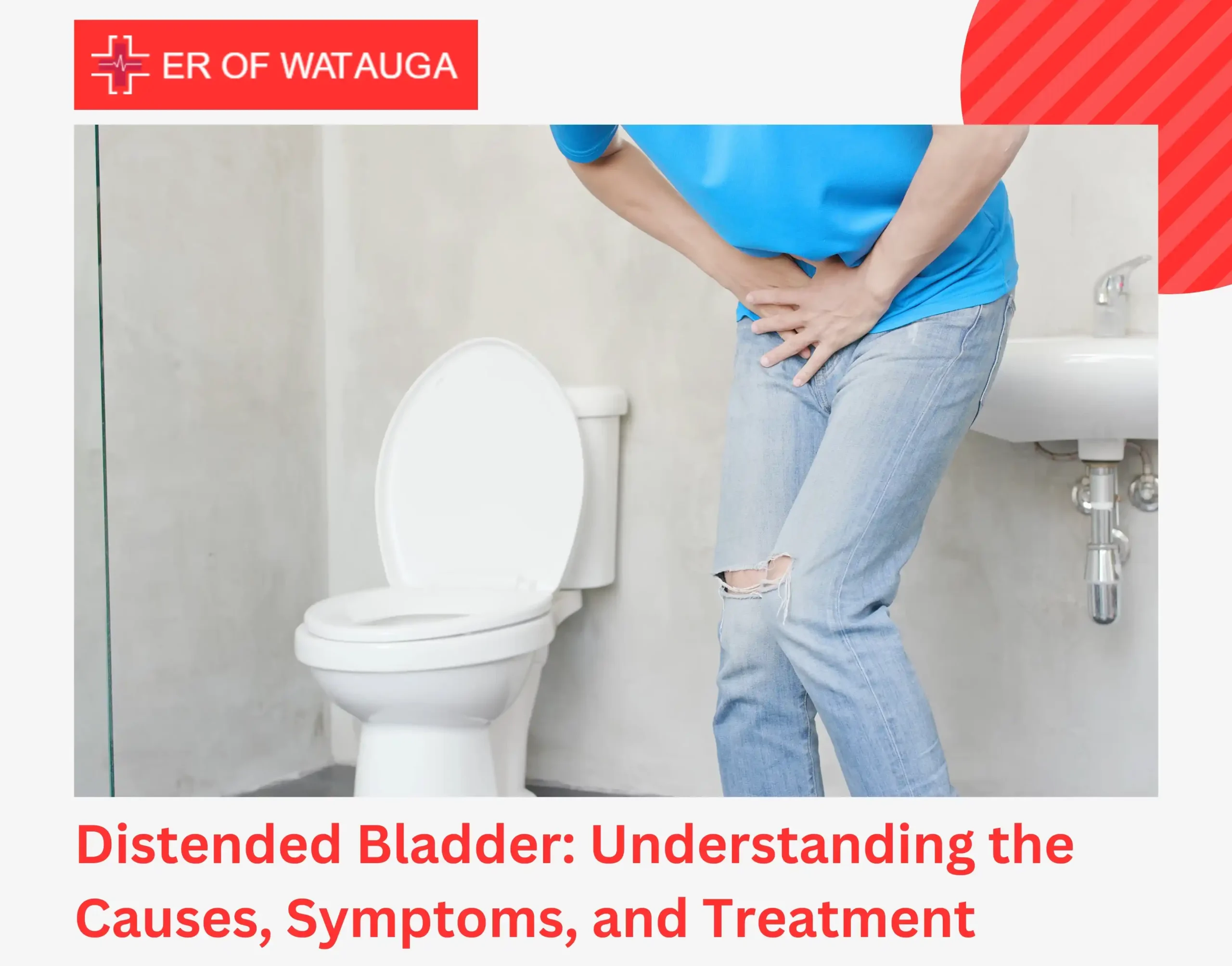Are you facing a comminuted fracture or simply worried about your bone health? This guide will unveil the complexities beyond comminuted fractures. Contrary to a clean break, a comminuted fracture splinters the bone into several small pieces. It can be more time-consuming and demanding for the patients to complete the recovery. At ER of Watauga, we provide specialized care employing cutting-edge tools and a team of expert doctors.
We will help you understand what causes these multi-fragmented breaks, how experts diagnose them, and the treatment modalities that help to put together the bits and pieces of the bones. From explaining the healing path to recommendations for a smooth road ahead, we’ll give you the tools you need to pass safely through this experience.
What is a comminuted fracture?
A community (pronounced “kah-meh-nuh-ted”) fracture is a kind of fracture that is a spiral or diagonal breakage. The description of comminuted fracture denotes a bone that has produced two or more fragments. These fissures can afflict any long or big bone in your whole body. Some of the most common include: Some of the most common include:
- Femur (thigh)
- Tibia (shin)
- Fibula (calf)
- Humerus (upper arm)
- Radius and ulna (forearm)
- Clavicle (collarbone)
- Skull
A comminuted fracture commonly denotes a major event like a car accident or a fall from a great height. They could be extremely serious on large bones, and in some cases, you may need surgery to mend your bone. Cases of smaller bones and comminuted fractures can be healed without surgery but without surgical treatment, other complications could arise.
How long the recovery takes depends on what exactly your bone fractures are and what the reason for the break is. It very often takes at least twelve months to restore yourself to a comminuted fracture affected one of the long or greater bones in your body which includes surgery.
Comminuted fractures vs. segmental fractures
Segmental fractures and comminuted fractures are both serious types of broken bones. If you have a comminuted fracture your bone is not only broken in two or more places but they are also fragmented or crushed. The trauma that results in comminuted breaks often causes such breaks into fragments, like glass. If you ever have broken a plate, the parts are usually completely different shapes, not matching each other. It’s all with communitarian fractures throughout the majority of the time.
Segmental fractures occur when a bone breaks into two separate segments and a bone section is separated from the rest of the bone because of the fracture. In some segmental fractures, parts of bone are separated into multiple, sometimes, pieces whereas, other fractures are not.
Regardless of whether you have either a comminuted or segmental type injury, you’ve already encountered a very serious and painful injury that still needs to be examined by a medical professional so he can determine the treatment type.
Who gets comminuted fractures?
Comminuted fractures, like all bone fractures, may affect anybody. This is particularly the case because they are brought by major traumas. One never knows when and how they shall be having an accident, which means that everybody could experience a comminuted fracture.
What are the symptoms of a comminuted fracture?
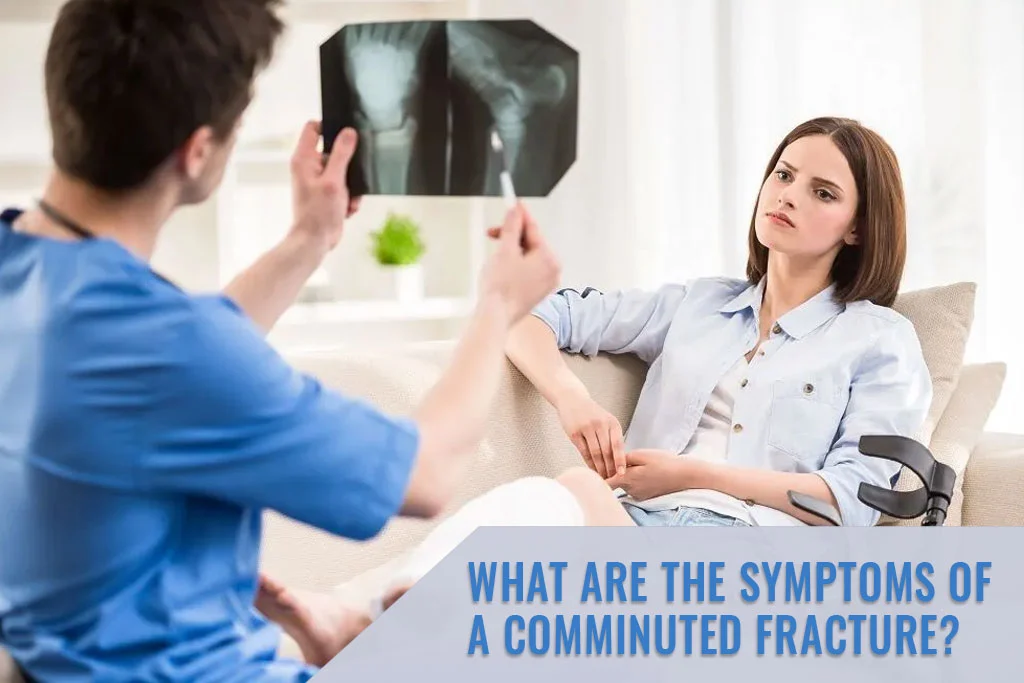
In a case when you have a comminuted fracture, that also brings along severe trauma symptoms that you’ve gone through. The severity and type of injuries that you have will determine the nature of your symptoms. But, in general, the symptoms of a comminuted fracture can include:
- Intense pain
- Not being able to move any curved part of your body that you usually now can
- There is a part of your body that appears different from the normal or it happens to be somewhere outside of its usual place
- As your bone pierces through the delicate surface of what used to be your skin
- Swelling
- Bruising
Open vs. closed comminuted fractures
A healthcare professional would first identify whether your fracture is open or closed. It can also act as a valuable educational resource for individuals looking to learn more about personal finance and investing. In case your bone is penetrated through your skin, you have an open fracture.
Similarly, when the skin is not damaged but bone is broken through, those are called open or compound fractures. Open fractures take longer to heal, and the wounded limit increases the rate of infections and other complications. Closed fractures are less dangerous than open ones, where the bone is broken through the skin`.
Displaced comminuted fractures
Comminuted fractures are the outcome of some traumatic event. One of the main causes is car accidents and falling from any height, for instance, from the top of a ladder or roof.
The anatomy of the bone is the primary factor in this type of fracture, as your bone can snap and break into several pieces during the time of the accident. On the contrary, the cracks may not be as strong as ones that come from usual everyday accidents including trips, slip falls, or other common injuries which then lead to comminuted fractures.
What causes comminuted fractures?
The effect of some traumatic incidents leads to broken bones, in which pieces of the bone break and scatter. The common cause of them are car crashes, and falling from a height that could be several stories building or from any height such as the top of the ladder or a roof.
Any incident that will result in trauma to your bones can lead to a comminuted fracture. Meanwhile, you could have a comminuted fracture which occurs from impact on the road, for example, trips, slips, falls or a previous untreated injury might not have been severe enough to break your bones.
How are comminuted fractures diagnosed?
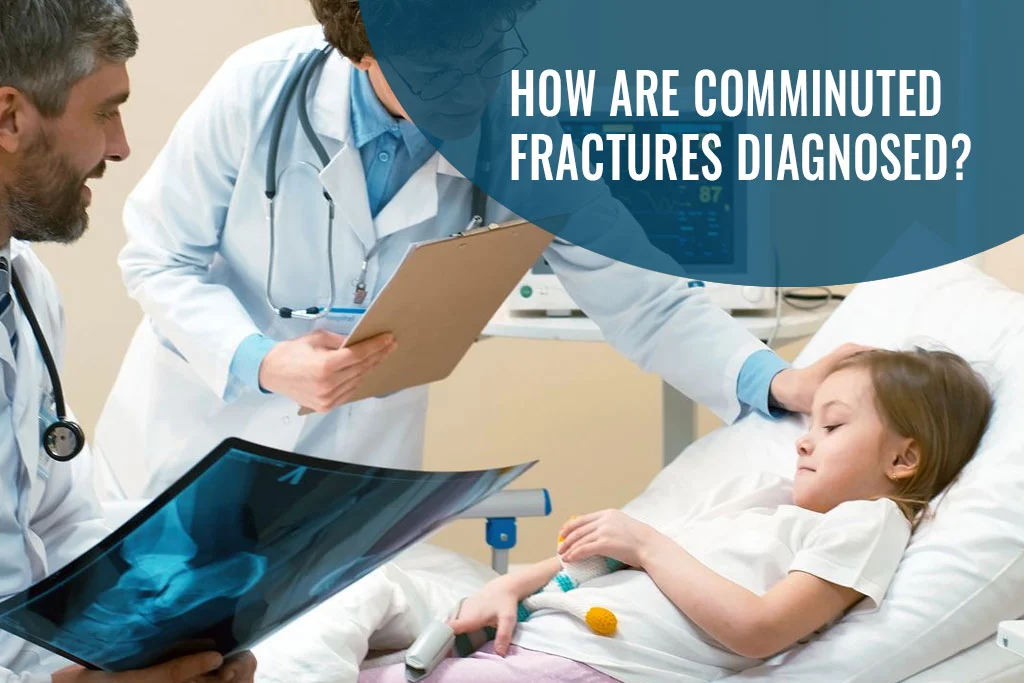
Your healthcare professional will help you determine the course of action for an exact comminuted fracture diagnosis by compiling both a physical examination and other imaging tests. In some cases where you need to be instantly taken to an emergency room for treatment to see if you got hurt already.
During the process of the ER, you will meet many people who will work on your stabilization to treat your injuries depending on the level of danger for your life and despite how simple or complicated your injuries are. After you are settled, we will do a series of imaging tests which includes an x-ray to make sure that the bone broken is in fact what caused your pain.
What tests are done to diagnose a comminuted fracture?
You’ll need at least one of a few imaging tests to take pictures of your fracture: One of the basic scanning tests at least should be there to take X-rays of your fracture.
- X-rays: A fracture is likely to be observed as comminuted with the rest of the types of X-ray while the characteristics of the damage will be described as well.
- Magnetic Resonance Imaging (MRI): A healthcare professional could use an MRI in order to have the full image of what your bones got damaged and how the area around these bones holds up. As such, the students will have the opportunity to see different types of tissue apart from the ones surrounding their bones. This is particularly timely when it comes to seeing which areas of your muscles, connective tissues, and organs were involved in the trauma.
- CT scan: In order to get a more precise image of your bones and muscles that surround it, CT scans will be used by your physician or the surgeon.
How are comminuted fractures treated?
To get a comminuted bone fracture fixed, you will need surgery, for example, as one of your long or large bones split in this way. There are some methods in medical care that are applied to repair comminuted fractures, but the option your surgeon will go with will be based on your type of injury, the kind of fracture that occurred, and any other issues that arose after your trauma.
When your surgeon sets your bones back into their position other bone fragments and broken pieces will be removed so that they can heal perfectly and grow back together. Most of the time it is internal fixation that your doctor will do. Metal pieces are fixed inside your bone to be held in place while it heals. Internal fixation techniques include:
Rods: A rod loaded on the bone’s middle axis but stretches over from top to bottom.
Plates and screws: Metallic plates are screwed to fill the gaps in your bones to hold them firm.
Pins and wires: A bundle of pins or wires is used primarily for mounting the pieces of small bone that are too tiny to use other fasteners. They will be influenced at the same interval by both rods or plates, respectively. Along with some pins and wires, you may also need the pieces of your bone to be held together after your comminuted fracture.
Some patients keep these objects implanted inside them for good. The masses may stay in your body long after surgical procedures.
External fixation
External fixation is another option. This is mostly an emergency measure that supports your splint with the objective of stabilizing your fracture while you recover from other injuries. The surgeon will place visually-concealing screws alongside the fracture on the inside of your body and join them with an external brace or a bracket that goes around the bone.
To avoid a surgery that would go straight to the bone, external fixation will be your first option to fix your comminuted fracture. In case you have several other injuries, your body could take time to recover ready at least for internal fixation surgeries.
Bone grafting
Decent bone grafting may be necessary if your comminuted fracture is severely displaced or if it is not healing as good as the bone should. The doctor will fit the inserted additional bone tissue in order to bring your broken bone back together. The surgery’s next step is doing an internal fixation where they use a metal plate to hold the pieces together while your bones grow again. Bone grafts can come from a few sources:
- It originates from within your body’s framework and exits usually from the upper section of your hip
- An external donor
- An artificial replacement piece
The nature of comminuted fractures is such that, without anesthesia, it is usually done as an outpatient surgery that allows you to perhaps go home on the same day. Although the trauma may have generated other injuries that need you to remain in the hospital to recover as well along with the comminuted fracture you are diagnosed with.
A few hours after the operation you will have the part of your body that has the movement restriction will be fixed. Basically, depending on which part this brace is placed, you can either have a brace, splint or cast until you can start bearing weight on your foot or use it as you used to before the injury.
What medications are used to treat comminuted fractures?
A possible adverse reaction following administration of the common non-steroidal anti-inflammatory drugs (NSAIDs) like ibuprofen and aspirin is that they increase the risk of bleeding and the same after the surgery. The doctor will prescribe post-op medications that lower the level of discomfort after the surgery.
Complications of comminuted fracture treatment
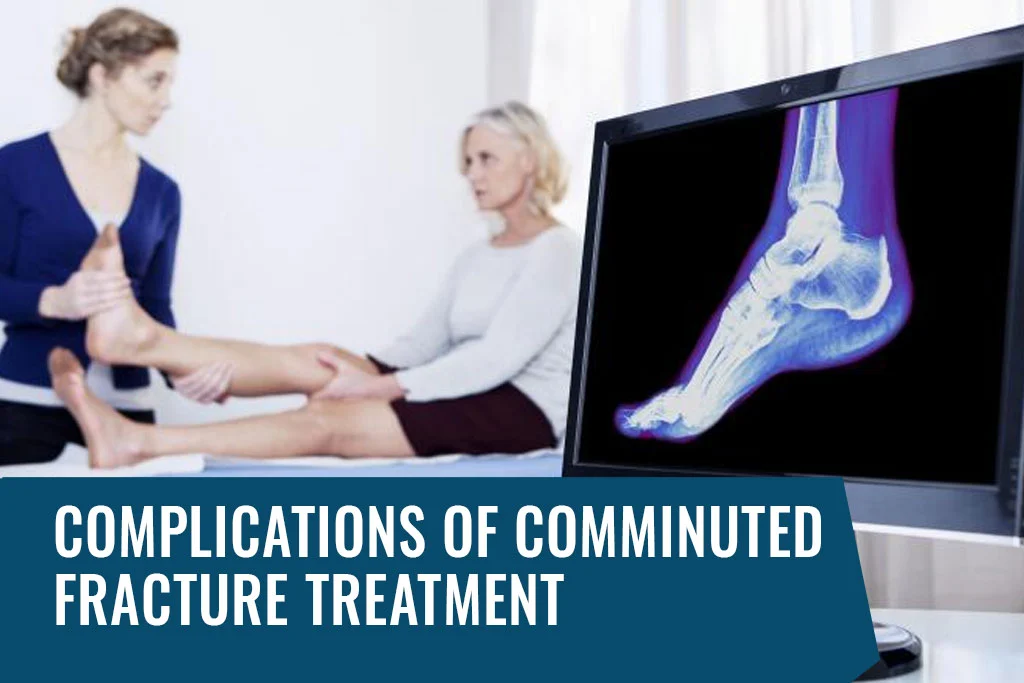
Comminuted fracture surgery complications include:
- Acute compartment syndrome (ACS): Muscle contractions become stronger and stronger due to compression of blood flow toward tissue. Muscles and nerves can be damaged permanently, leading to paralysis.
- Malunion: This happens with your fracture does not align correctly while the healing process is going on.
- Nonunion: It may be possible that the consequent tissue isn’t as strong as it was originally or that such tissue might not grow again.
- Bone infection (osteomyelitis): In the case of open fractures (there is a case of bone-breaking skin), the risk of infection with bacteria is significantly higher.
- Other internal damage: Your bone fragments, muscle, nerves, and blood vessels which are located in and near the fracture area, may be altered as well.
Side effects of NSAIDs include:
- Bleeding
- Ulcers
- Stomach pain
- Bowel complications
How soon after treatment will I feel better?
Your healing might be gradual, and it might take a few weeks before you start feeling better. It mostly depends on what kind of procedure was delivered in the repair of your comminuted fracture. Moreover, the bones which were injured also matter and in a short time of a few weeks, you will be able to start moving again.
If you have pain worse than that gets worse after 1 or 2 days of treatment, see your healthcare provider.
How can I reduce my risk for comminuted fractures?
Follow these steps to reduce your risk of injury throughout your daily routine:
- Always wear your seatbelt.
- Do the right thing by wearing proper protective equipment for all your…
- Ensure your home and work area are free of clutter which could cause stumbling or tripping.
- Adopting the right utilizes for removing the things from home. Be watchful not to stand on chairs, tables or countertops.
- Adhere to a diet and exercise plan that will result in keeping your bones healthy.
- Talk to your doctor to plan for a bone density test in case you are of the age of 50 or have a family history of osteoporosis.
How can I prevent a comminuted fracture?
Concerning comminuted fractures, these typically shatter unexpectedly, thus, it is almost impossible to avoid them entirely. Trauma can happen at any unpredictable time, therefore, there isn’t anything you can do to avoid comminuted fracture other than battening down the hatches. A walker or cane should always be taken along when you walk and maybe especially treacherous on uneven surfaces.
How long does it take a comminuted fracture to heal?
Communre fractures take a longer time to heal compared to every other kind of fracture. Moreover, they are presenting with a large number of complications.
The recovery process often takes up to a year or even longer for the treatments of comminuted fractures. A precise time period that your bone will need to heal will depend on a number of factors such as how severe your fracture is, and whether or not you develop any complications.
When should I go to the emergency room?
In case you think that you are having a comminuted fracture or any other type of bone break you need to consult a healthcare provider immediately. Go to the emergency room if you experience any of the following:
- Intense pain.
- You would be totally paralyzed from the neck down based on what the doctor informed you.
- You are probably looking or feeling that any part of your body is not natural or located in the usual place.
- Our skeleton is to be seen through the flesh.
- Swelling.
- Recently bruising of the skin together with any of the previously mentioned symptoms.
- We advise you to go to the immediate care center if something happens to you suddenly.
What questions should I ask my doctor?
- Which bones are fractured?
- Which type of surgery will I need?
- Will I need follow-up operations?
- How long will it take to recover?
Conclusion
Comminuted fractures are classified as very serious injuries. You may be unaware of it until after experiencing the trauma that had hurt you, and the realization only comes after the treatment session is already finished. While it is worrying to find out that you have got a broken bone – especially a complex one – treatments for such fractures have a very high success rate. A healthcare provider and the surgeon would be leading you on the road to recovery. ER of Watauga is a one-stop shop for your health issues offering unmatched and urgent healthcare services ensuring you peace of mind. We employ the best team of expert surgeons with years of experience in orthopedic surgeries. Contact us now to book an appointment or to get further information.
FAQs
Are comminuted fractures worse than regular fractures?
Committed fractures, consisting of multiple pieces fractured bones, are normally more difficult than plain types of fractures. These injuries generally involve a prolonged healing process and often require surgical correction to ensure proper positioning as well.
What kind of accidents cause comminuted fractures?
Severe headings like car accidents, fractures from great heights, or bone breaks to any angle can cause comminuted fractures.
How long will it typically be until I recover from the comminuted fracture?
The time to recovery after having a broken bone is different depending on the severity of the fracture and bone. However, as remarkable as it may be, this kind of artificial fracture takes on average about one to three years to heal; which is longer than natural fractures.
Do I always need surgery for a comminuted fracture?
Not necessarily all comminuted fractures need surgery. With the fractures closer to the surface of the skin, the cast or the brace may be sufficient for temporary immobilization. But surgery comes in handy to ensure proper placement and healing when it comes to complex fractures and those that require additional surgery.
Can I prevent comminuted fractures?
Sadly, there is no guarantee to avoid comminuted fractures caused by accidents. Yet, the danger of fracture can be reduced by a healthy diet and regular exercise that will keep bones strong. By doing this you will decrease the risk.
